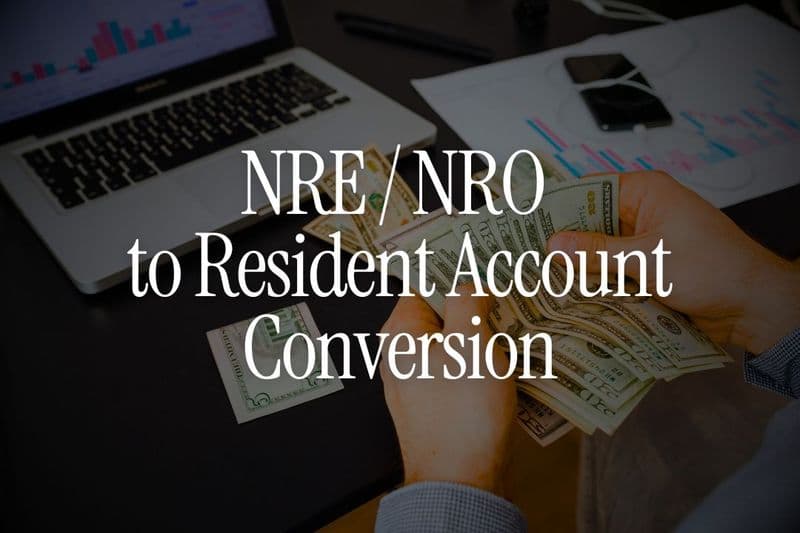
Last week, a client called us from Bangalore airport and said...
“My company transferred me back after 8 years in Dubai. What do I do about my NRE account? Can I keep using it?"
We hear this question every month. The answer is no-and the consequences of ignoring this are expensive.
If you're moving back to India permanently, converting your NRI accounts to resident accounts isn't optional. It's a legal requirement under FEMA.
Let us walk you through the exact process, timelines, and smart strategies to protect your money during this transition.
Why You Must Convert (And What Happens If You Don't)
The moment you become a resident under FEMA guidelines, you cannot operate NRE or NRO accounts.
FEMA considers you a resident if you intend to stay in India for more than 182 days or have ended your employment abroad with plans to settle in India. (Heads up: A 2025 tribunal ruling stresses that 182 days of actual presence in the prior year seals the deal for some cases-double-check with your bank to avoid surprises.) (source)
Penalties for non-compliance:
- Up to 3 times the amount involved
- Or ₹2 lakh (if amount isn't quantifiable)
- Plus daily penalty of ₹5,000 from the first day of violation
- Account freeze without warning
- Income tax filing complications
One of our clients ignored the conversion for 8 months. His bank froze all accounts when he tried transferring ₹15 lakh for a property purchase. He paid ₹4.2 lakh in penalties to resolve it.
Not worth the risk.
Use our Residential Status Calculator to know exactly when your status changes.
Also Read - Difference Between NRI and Resident Tax Filing in India
Before You Start: Understanding Your Options
You have three account conversion paths:
Your Current Account | Conversion Option | What Happens |
|---|---|---|
NRE Savings/Current | → Resident Savings Account | Same account number, re-designated immediately |
NRO Savings/Current | → Resident Savings Account | Same account number, funds stay in INR |
NRE/FCNR Fixed Deposits | → Resident FD OR → RFC FD | New deposit number, can continue till maturity |
👉 Tip: Don't rush to close your NRE account. Consider converting to an RFC (Resident Foreign Currency) account first if you have substantial forex savings. More on this later.
Step 1: Notify Your Bank Immediately
Timeline: Within 2-4 weeks of return
Contact your bank the moment you know you're staying in India permanently.
Three ways to notify:
- Visit your branch (fastest for documentation)
- Call customer care and request conversion forms
- Use internet banking (select banks offer online forms)
For major banks:
Don't assume the bank will automatically detect your status change. They won't.
Step 2: Gather Required Documents
The documentation is straightforward but must be complete.
Core documents:
- Passport with India entry stamp
- Updated PAN card
- Current address proof in India (Aadhaar, utility bill, rental agreement)
- Photographs (2-3 passport-size)
- Existing account details
KYC forms to fill:
- Resident Account Conversion Form (bank-specific format)
- Updated KYC form with Indian address
- FATCA/CRS declaration
- Form 60 (if PAN isn't updated) or Form 61
For joint accounts:
- All account holders must sign
- If joint holder is still NRI, submit undertaking allowing continuation
Download forms from your bank's website or collect them from the branch. Don't rely on email attachments-they're often outdated versions.
Step 3: Submit Forms and Documents
Timeline: Bank processes in 7-14 days
Visit your branch with all documents. If you're in another city, most banks accept courier submissions to their designated NRI processing centers.
What happens at submission:
- Branch verifies documents
- Updates residential status in system
- Issues acknowledgment receipt
- Initiates account re-designation
Your account number stays the same for savings/current accounts. FDs get new numbers.
Step 4: Handle Fixed Deposits Separately
This is where people make expensive mistakes.
For NRE Fixed Deposits:
As per RBI rules, NRE FDs must be re-designated as resident FDs immediately when status changes.
You have two choices:
- Convert to resident FD (loses tax-free status, interest becomes taxable)
- Convert to RFC FD (keeps foreign currency, special tax benefits if you're RNOR)
For FCNR Deposits:
These can continue till maturity without conversion. No premature withdrawal penalty if you held them for 1 year or more.
Compare rates across banks using our NRI FD Comparison Tool.
Step 5: Update Linked Services
Account conversion is just the first step. Update everything linked to your NRI accounts.
Demat account:
- Submit separate conversion forms for NSDL/CDSL accounts
- Update KYC from NRI to resident status
- Check if trading account needs re-opening
Mutual funds:
- Update KYC with AMCs through KRA
- Change bank mandate from NRE/NRO to resident account
- Verify if SIPs continue running
Also Read - What Happens to Mutual Funds If You Return to India (RNOR → Resident)
Insurance policies:
- Inform insurers about residential status change
- Update premium payment account details
Loans:
- Notify bank if you have NRI home loans
- May need to switch to resident loan terms
For investment compliance, use our Compliance Compass tool.
The RFC Account Strategy (Smart MoneyMove)
Here's what most returning NRIs miss: you can keep foreign currency in India through RFC accounts.
An RFC (Resident Foreign Currency) account lets you hold USD, EUR, GBP, or other currencies as a resident.
Why this matters:
Imagine you have $50,000 in your NRE account and you return when the dollar is at ₹82. If you convert everything to rupees immediately, you lock in that rate.
But if you transfer to an RFC account instead:
- Funds stay in dollars
- You can convert portions as needed
- You avoid exchange rate risk
- If you have RNOR status, interest is tax-free
One client saved ₹10.39 lakh in taxes over 2 years by using an RFC account during his RNOR period.
RFC account eligibility:
- You must have been an NRI previously
- You're now a resident in India
- Funds come from legitimate NRI sources
Permitted credits:
- Transfer from NRE/FCNR accounts
- Foreign pension or salary
- Sale proceeds of overseas assets
- Inheritance or gifts from abroad
Permitted debits:
- Conversion to rupees anytime
- Payments abroad without LRS restrictions
- Investments in Indian markets
- Transfer to other RFC accounts
Learn more about GIFT City investments and GIFT City benefits for NRIs for alternative ways to keep forex exposure.
Also Read - Residential Status Under Section 6 Of Income Tax Act
Tax Implications You Cannot Ignore
Your tax treatment changes the day you become a resident.
As NRI:
- NRE account interest: Tax-free
- NRO account interest: 30% TDS (reduced by DTAA)
- Foreign income: Not taxable in India
As Resident:
- All bank interest: Taxable at slab rates
- TDS applies on interest above ₹50,000 (₹1,00,000 for senior citizens)
- Global income becomes taxable
Exception: RNOR status
If you qualify as Resident but Not Ordinarily Resident (RNOR), you get a grace period.
RNOR eligibility:
- You were NRI for at least 2 out of last 10 years
- OR you were in India for less than 730 days in last 7 years
RNOR benefits:
- Foreign income remains non-taxable
- RFC account interest is tax-free
- Foreign assets don't need to be reported immediately
This status lasts until you fail both conditions. For most returning NRIs, that's 2-9 years depending on how long you were abroad.
Read our complete guide on NRI taxation and residential status under income tax.
Common Mistakes That Cost Money
Mistake 1: Converting everything to INR immediately
Exchange rates fluctuate. One client converted $80,000 at ₹82 in January. By June, the rate hit ₹86. He lost ₹3.2 lakh in potential gains.
Use RFC accounts to maintain forex exposure.
Mistake 2: Not updating joint accounts properly
If you're returning but your spouse is still abroad, you need special undertakings. Otherwise, the bank freezes joint accounts.
Mistake 3: Forgetting about NRO repatriation limits
NRO accounts have a repatriation limit of $1 million per financial year. If you have more, plan conversions across multiple years.
Learn about NRO and NRE fixed deposits for better planning.
Mistake 4: Ignoring old FDs and recurring deposits
Banks won't automatically convert locked deposits. You must give explicit instructions for each FD.
Mistake 5: Not planning for future moves
If there's any chance you'll go abroad again, keeping RFC accounts makes sense. You can easily convert RFC back to NRE if you become an NRI again.
Timeline Expectations
Here's the realistic timeline for complete account conversion:
Activity | Expected Time |
|---|---|
Bank notification | Same day |
Document submission | 1-3 days |
Account re-designation | 7-14 days |
Demat account update | 10-15 days |
Mutual fund KYC update | 7-10 days |
New debit card issuance | 7-10 days |
Internet banking update | 2-3 days |
Cheque book replacement | 5-7 days |
Total: 2-4 weeks for complete transition if you have all documents ready.
Delays happen because of:
- Missing documents
- Unclear passport stamps
- Joint holder signatures pending
- Bank backlogs (especially April-June)
Your Checklist for Smooth Conversion
Before you start:
- Determine your exact residential status using our calculator
- Decide on RFC vs resident account strategy
- Collect all required documents
- Make copies of passport stamps proving return date
Week 1:
- Notify all banks where you hold NRI accounts
- Collect conversion forms from branches
- Submit completed forms with documents
Week 2-3:
- Follow up on account re-designation
- Update demat and trading accounts
- Inform mutual fund houses and AMCs
Week 4:
- Verify all accounts showing resident status
- Update insurance and loan accounts
- Test internet banking and cards
Ongoing:
- File ITR as resident (if status changed mid-year, file as per actual days)
- Monitor DTAA benefits if you have foreign income
- Review NRI tax exemptions and deductions you can still claim
What About Your Overseas Investments?
Good news: becoming a resident doesn't force you to liquidate foreign assets.
You can continue holding:
- Foreign bank accounts
- Overseas stocks and mutual funds
- Property outside India
- Business interests abroad
What changes:
- You must report foreign assets in your ITR
- Income from these assets becomes taxable in India
- Remittances from India fall under LRS ($250,000/year limit)
- 20% TCS applies on LRS remittances above ₹10 lakh
Read about India-USA DTAA and India-UAE DTAA rules if you have income in those countries.
Moving Forward: Building Your India Financial Life
Converting accounts is just the beginning of your financial transition.
As you settle back in India, think about:
- Emergency fund in INR (6 months expenses)
- Health insurance (your NRI policy likely won't cover you)
- Term insurance with Indian insurers
- Retirement planning with NPS or mutual funds
- Property purchase decisions (read our real estate guide for returning NRIs)
While you're rebuilding your India finances, don't forget the power of diversification. At Belong, we help NRIs maintain USD exposure through GIFT City fixed deposits-even after you become a resident.
These deposits offer:
- Tax-efficient returns in USD
- Protection from rupee depreciation
- Full repatriation flexibility
- No LRS restrictions
👉 Download the Belong App to explore how GIFT City can complement your resident banking.
Connect with other returning NRIs navigating the same transition. Join our WhatsApp Community to share experiences and get answers to your specific questions.
Also Read -Step-by-Step Guide to Converting Resident Account to NRI Account
Sources:
Reserve Bank of India – FEMA Guidelines on NRI Accounts
RBI Notification on Foreign Currency Accounts – January 2025 (FEMA 10(R)(5)/2025-RB)
ICICI Bank – Returning NRIs Account Conversion Process




